check engine light AUDI A4 2013 Owner's Manual
[x] Cancel search | Manufacturer: AUDI, Model Year: 2013, Model line: A4, Model: AUDI A4 2013Pages: 302, PDF Size: 75.61 MB
Page 230 of 302
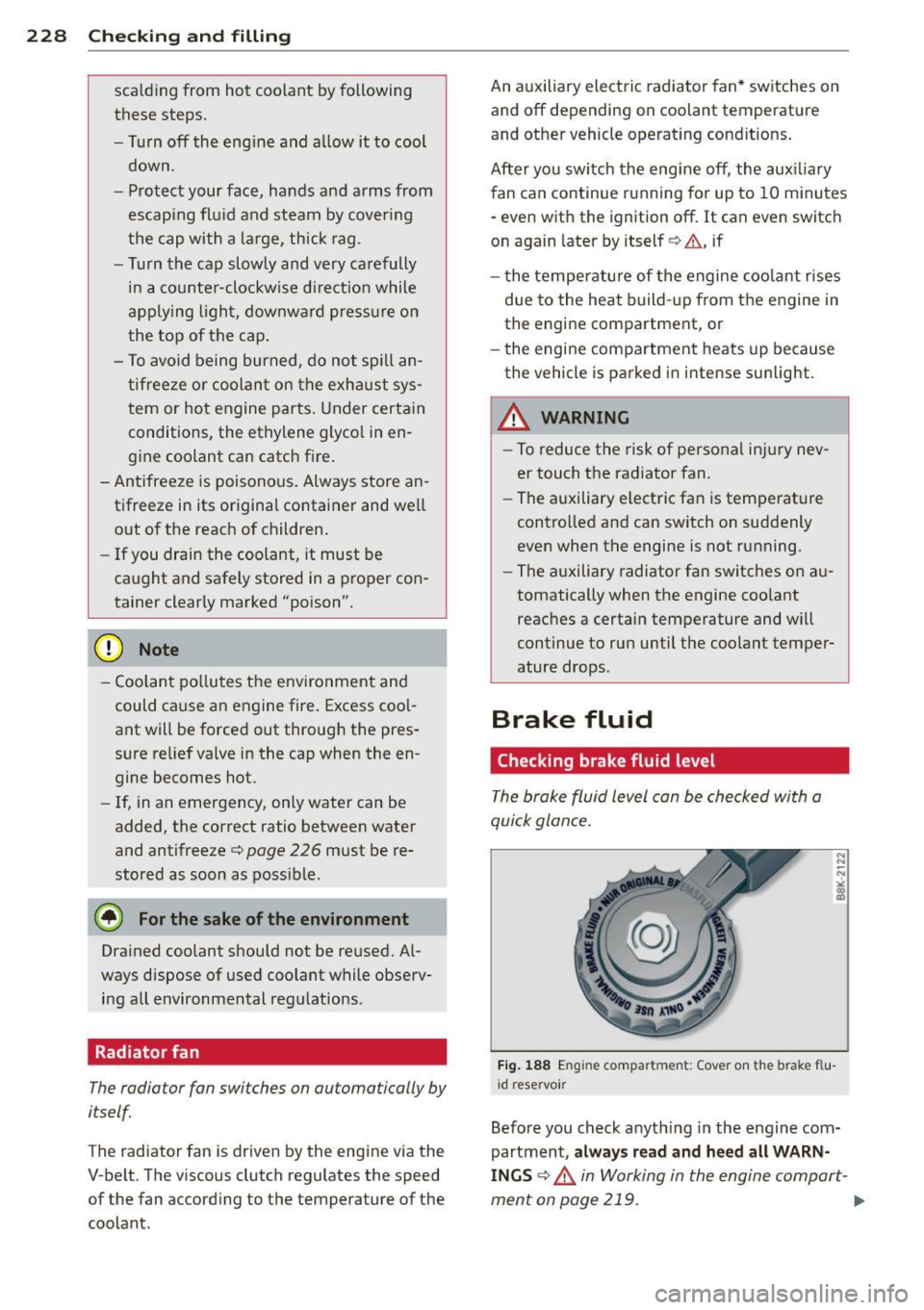
228 Check ing and filling
scalding from hot coolant by following
these steps .
- Turn off the eng ine and allow it to cool
down.
- Protect your face, hands and arms from escaping flu id and steam by cover ing
the cap with a large, thick rag .
- Turn the cap slowly and very carefully
i n a counter-clockwise direction while
apply ing l ight, downwa rd press ure on
the top of the cap .
- To avo id being burned, do not spi ll an
tifreeze or coolant on the exhaust sys
tem or hot engine parts . Under certain
conditions, the ethylene glyco l in en
gine coolant can catch f ire .
- Antifreeze is poisonous . Always store an
tifreeze in its or iginal container and we ll
out of the reach of children.
- If you drain the coolant, it must be
caught and safely stored in a proper con
tainer clear ly marked "poison".
@ Note
- Coolant po llutes the env ironment and
could cause an engine fire . Excess coo l
ant will be forced out through the pres
sure re lief valve in the cap when the en
gine becomes hot.
- If, in an emergency, only water can be
added, the correct ratio between water
and antifreeze
c::> page 226 must be re
stored as soon as possible .
@ For the sake of the environment
Drained coolant should not be re used. Al
ways dispose of used coolant while observ
ing all environmental regulat ions .
Radiator fan
The radiator fan switches on automatically by
itself
T he radiator fan is driven by the engine via the
V-be lt . The viscous clutch regulates the speed
of the fan accord ing to the temperature of the
coolant. An a
uxiliary electric radiator fan* switches on
and off depend ing on coolant temperature
and other vehicle operat ing condit ions .
After yo u sw itch the engine off, the aux iliary
f an can continue running for up to 10 minutes
- eve n wit h the ignit ion off. It can even switc h
on again later by itself
c::> &. , if
- t he tempe rature of the engine coo lant rises
due to the heat build -up from the engine in
the engine compartment, or
- the engine compa rtment heats up because
the vehicle is parked in i ntense sunlight.
_& WARNING
- To reduce the risk of personal injury nev
er touch the radiator fan.
- The auxiliary electric fan is temperat ure
controlled and can sw itch on suddenly
even when the engine is not running.
- The a uxiliary radiator fan sw itches on au
tomatically when the engine coo lant
reaches a certai n temperature and will
continue to run until the coolant temper
ature drops .
Brake fluid
Checking brake fluid level
The brake fluid level can be checked with a
quick glance.
F ig . 1 88 Engin e compart men t: Cover on the b rak e flu
i d reservo ir
Before you check a nyth ing in the engine com
partment,
always read and hee d all WARN
INGS c::> .&. in Working in the engine compart-
ment on page 219 . .,..
Page 231 of 302
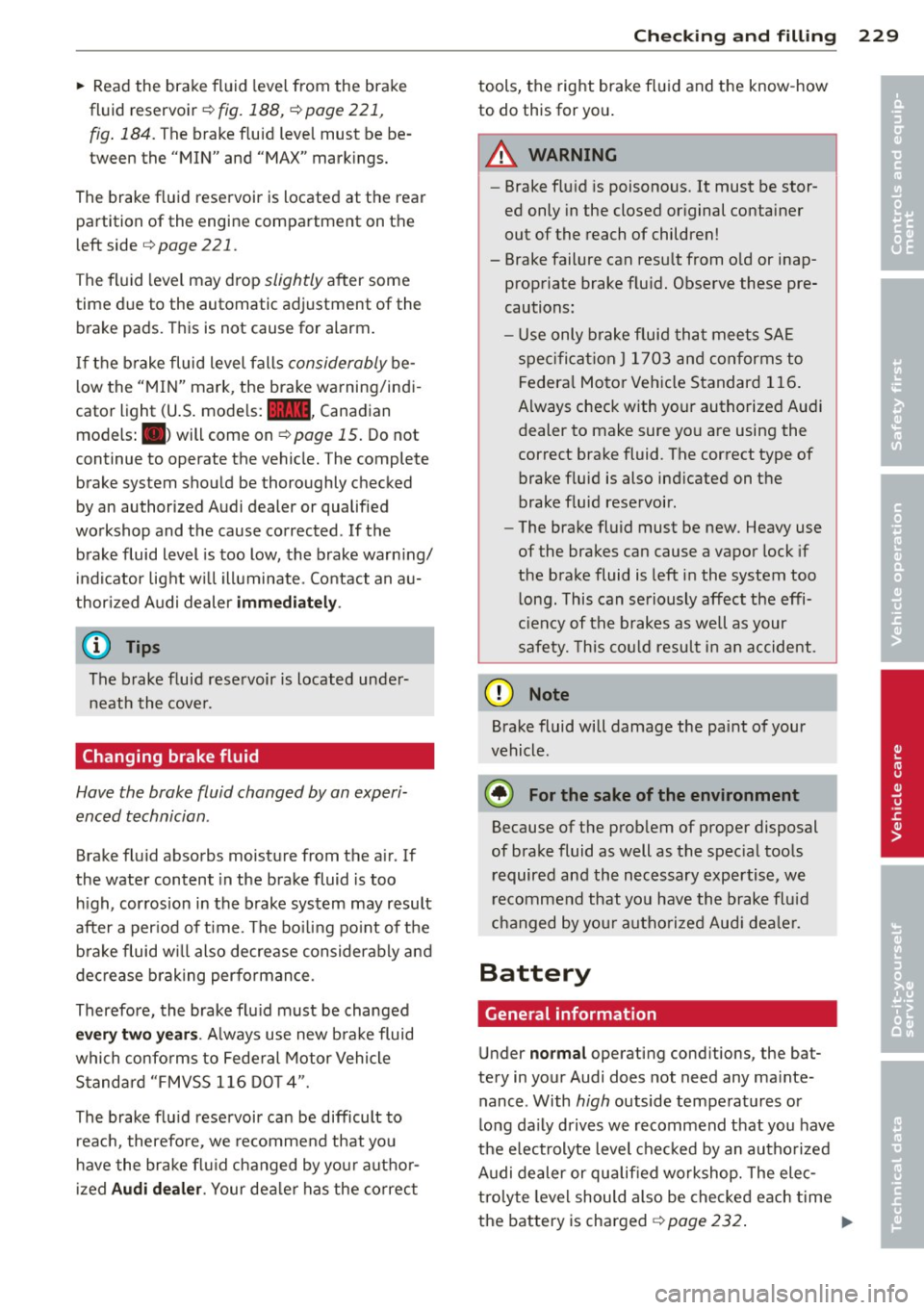
~ Read the brake fluid level from the brake
fluid reservoir ~
fig. 188, ¢ page 221,
fig . 184.
T he brake fluid level must be be
tween the "MIN" and "MAX" markings.
The brake f luid reservoir is located at the rear
partition of the engine compartment on the
l eft side
¢ page 221 .
The fluid level may drop slightly after some
time due to the automatic adjustment of the brake pads . This is not cause for alarm .
If the brake fluid level falls considerably be
l ow the "M IN" mark, the bra ke wa rning/ind i
cator light (U .S . mode ls:
1111 , Canadian
models: .) will come on
¢ page 15. Do not
continue to operate the vehicle. The complete
brake system shou ld be thoroughly checked
by an authorized Audi dealer or qualified
workshop and the cause co rrected . If the
b rake fluid level is too low, the b rake wa rn ing/
i nd icator lig ht w ill illuminate . Co ntact an a u
thor ized Audi dealer immediately.
@ Tips
The brake f luid rese rvoir is located unde r
neath the cove r.
Changing brake fluid
Have the brake fluid changed by an experi
enc ed technician .
Brake fluid ab sorbs moisture from the a ir. If
the water content in the brake fluid is too
hi gh, corrosion in the b rake system may result
after a per iod of t ime . The bo iling po int of t he
b ra ke fluid w ill also decrease con siderab ly and
d ec rease brak ing per forman ce.
Therefore, the brake flu id must be changed
every two year s. Always use new b ra ke fluid
which confo rms to Fede ral Motor Vehicle
S tand ard "FMVSS 1 16 DOT 4".
The brake flu id rese rvoir can be difficult to
r eac h, therefo re , we recommend that yo u
have the brake fl uid changed by yo ur aut ho r
iz ed Audi dealer. Your dealer has the correc t
Checking and fillin g 229
tools, the right brake fl uid and t he know -how
to do this for you .
A WARNING
- Brake fl uid is poisonous. It must be stor
ed only in the closed or iginal container
out of the reach of children!
- Brake failure can res ult from o ld or inap
propriate brake f lu id. Observe these pre
cautions:
- Use only brake fluid th at mee ts SA E
spe cificat ion
J 17 03 and conforms to
Fe dera l Mo to r Ve hicl e Standard 1 16.
Always check with yo ur autho rized Au di
dealer to make sure yo u are using the
correct brake fluid. The c orrect type of
brake f luid is also ind icated on t he
brake f luid reservoir .
- The bra ke fl uid must be new. Heavy use
of the brakes ca n cause a vapor lock if
the b rake fluid is left i n the system too
long. This can se riously affect the effi
c iency of the b rakes as well as your
safety , T his could result in an accide nt.
(!) Note
Brake fluid will damage the pai nt of your
vehicle.
@) For the sake of the environment
Because of the prob lem of proper disposal
of brake fluid as well as the spec ial too ls
r equired an d th e nec essary exper tise, w e
r ecomme nd that yo u have th e brake flu id
c hanged by yo ur aut ho rize d Aud i dea le r.
Battery
General information
U nder normal operating cond itions, the bat
te ry in your Audi does not need any ma inte
nance . With
high outside temperat ures or
lo ng da ily drives we recommend that you have
t h e e lectrolyte leve l che cked by an autho riz ed
A udi de aler or qu alified workshop. The elec
tro lyte leve l should also be checked e ach time
the battery is charged
¢ page 232 . 1J1>
•
•
Page 233 of 302

-Always wear eye protection. Do not let
battery acid or any lead particles get on
your skin or clothing. Shield your eyes .
Explosive gases can cause blindness or
other injury.
- Battery acid contains sulfuric acid . Sulfu
ric acid can cause blindness and severe
burns.
- Always wear gloves and eye protection.
Do not tilt the battery because acid
could leak out of the ventilation open
ings.
- If you get battery acid in your eyes or
on your skin, immediately rinse with
cold water for several minutes and get
medical attention .
- If you should ingest any battery acid,
seek medical attention immediately.
- Do not expose the battery to an open
flame, electric sparks or an open light.
- Do not smoke.
- Do not interchange the positive and neg-
ative cables .
= When working on the battery, be sure
not to short-circuit the terminals with
tools or other metal objects. This would cause the battery to heat up very quickly,
which could lead to damage or explosion and personal injury.
- When a battery is charged, it produces
hydrogen gas which is explosive and
could cause personal injury .
- Always keep the battery well out of the
reach of children.
- Before work is done on the electrical sys
tem, disconnect the negative ground ca ble .
- Before performing any work on the elec
trical system, switch off the engine and
ignition as well as any electrical equip
ment. The negative cable on the battery
must be disconnected . If you are just go
ing to replace a light bulb, then it is
enough to switch off the lights.
- Before disconnecting the battery, switch
off the anti-theft alarm system! Other
wise you will set off the alarm.
Checking and filling 231
-When disconnecting the battery, first
disconnect the negative cable and then
the positive cable.
- Before reconnecting the battery, make
sure all electrical consumers are switch
ed off. Reconnect the positive cable first
and then the negative cable . Never inter
change the cables -this could start a fire!
- Never charge a frozen or a thawed-out
battery . It could explode! If a battery has
frozen , then it must be replaced . A dis
charged battery can freeze over at 32°F
(QOC),
-Make sure the vent hose is always attach
ed to the opening on the side of the bat
tery .
- Never use batteries which are damaged.
There is the danger of an explosion! Al
ways replace a damaged battery.
&_ WARNING
California Proposition 65 Warning:
- Battery posts, terminals and related ac
cessories contain lead and lead com
pounds, chemicals known to the State of
California to cause cancer and reproduc
tive problems. Wash hands after han dling.
(D Note
- Do not disconnect the vehicle battery
when the ignition is switched on or when the engine is running, otherwise, you will
damage electronic components in the
electrical system.
- If your vehicle is going to stand for a
long period of time without being driven,
protect the battery from "freezing", oth
erwise it will be damaged and will then
have to be replaced.
•
•
Page 235 of 302
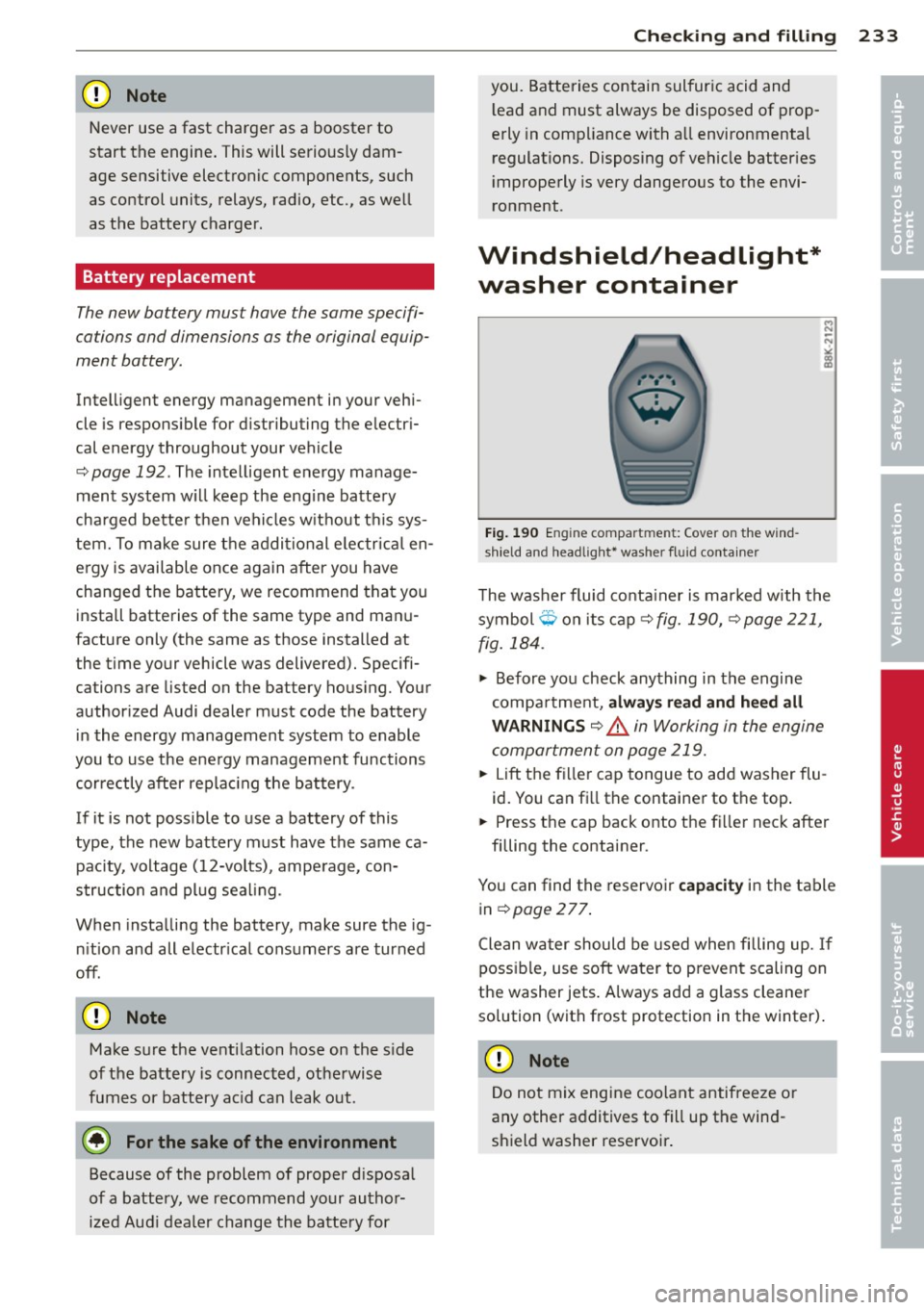
(D Note
Never use a fast charger as a booster to
start the engine . This will seriously dam
age sensitive electronic components, such
as control units, relays, radio, etc ., as well
as the battery charger .
Battery replacement
The new battery mu st have the same specifi
cations and dimensions as the original equip
ment battery .
Intelligent energy management in your vehi
cle is responsible for d istributing the electr i
cal energy throughout your vehicle
c::>
page 192. The intelligent energy manage
ment system w ill keep the engine battery
charged bette r then vehicles w ithout t his sys
tem. To make sure the additional electr ica l en
ergy is available once again after you have
changed the battery, we recommend that you
install batteries of the same type and manu
facture only (the same as those installed at
the time your vehicle was delivered). Specifi
cations are listed on the bat tery hous ing. Your
author ized Audi dealer must code the battery
in the energy management system to enable
you to use the energy management functions
correctly after replac ing the battery .
If it is not possible to use a battery of this
type, the new battery must have the same ca
pac ity, voltage (12-volts), amperage, con
struction and plug sea ling.
When insta lling the battery, make sure the ig
nition and all electr ical consumers are turned
off.
(D Note
Make sure the venti lation hose on the s ide
of the battery is connected , othe rwise
fumes or battery ac id can leak out .
@ For the sake of the environment
Because of the problem of proper d isposal
of a battery, we recommend your author
ized Aud i dealer change the battery for
Checkin g and fillin g 233
you. Batteries contain sul fur ic acid and
l ead and must always be disposed of prop
erly in comp liance with a ll environmental
regulations. Disposing of vehicle batter ies
i mproperly is very dangerous to the envi
ronment .
Windshield/headlight*
washer container
Fig. 190 En gin e compart men t: Cove r on the w ind
s hi eld an d headligh t* was her fl uid conta iner
The washer fluid container is marked w ith the
symbol
Q on its cap c::>fig. 190, c::>page 221,
fig. 184 .
.,. Before you check anything in the engine
compa rtment,
always read and heed all
WARNINGS
c::> .&. in Working in the engine
compartment on page 219.
.,. Lift the f iller cap tongue to add washer flu
id. You can fi ll the container to the top .
.. Press the cap back onto the fi ller neck after
filling the container .
You can find the reservoir
capacity in the table
in c::>
page 2 77 .
Clean water should be used when filling up.
If
possib le, use soft water to prevent scaling on
the washer jets . Always add a glass cleaner
solution (with frost protection in the winter) .
(D Note
Do not mix engine coolant antifreeze or
any other additives to fill up the wind
shield washer reservoir .
•
•
Page 271 of 302
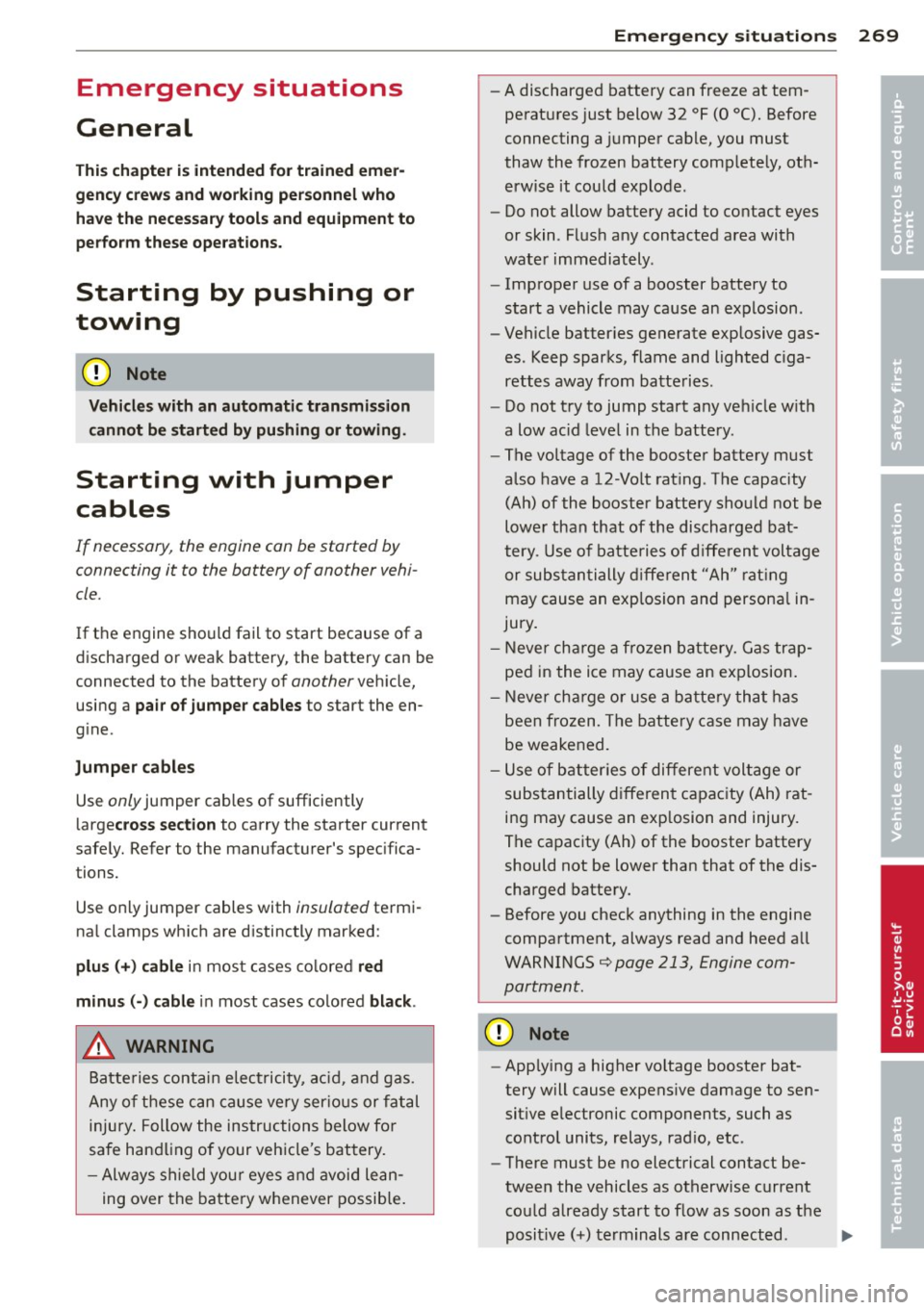
Emergency situations
General
This chapter is intended for trained emer
gency crews and working personnel who
have the necessary tools and equipment to
perform these operations.
Starting by pushing or
towing
(D Note
Vehicles with an automatic transmission
cannot be started by pushing or towing .
Starting with jumper
cables
If necessary, the engine can be started by
connecting it to the battery of another vehi
cle.
If the engine should fail to start because of a
discharged or weak battery, the battery can be
connected to the battery of
another vehicle,
using a
pair of jumper cables to start the en
g ine.
Jumper cables
Use only jumper cables of sufficiently
largecross section to carry the starter current
safe ly. Refer to the manufacturer's specifica
tions.
Use only jumper cables with
insulated termi
na l clamps which are distinctly marked:
plus(+) cable in most cases colored red
minus(-) cable
in most cases colored black .
A WARNING
Batteries contain electricity, acid, and gas.
Any of these can cause very serious or fatal
injury. Follow the instructions below for
safe handling of your vehicle's battery.
- Always shield your eyes and avoid lean
ing over the battery whenever possible.
Emergency situations 269
-A discharged battery can freeze at tem
peratures just below 32 °F (0 °C). Before
connecting a jumper cable, you must
thaw the frozen battery completely, oth
erwise it could explode.
- Do not allow battery acid to contact eyes
or skin . Flush any contacted area with
water immediately .
- Improper use of a booster battery to
start a vehicle may cause an explosion.
- Vehicle batter ies generate explosive gas
es. Keep sparks, flame and lighted c iga
rettes away from batteries.
- Do not try to jump start any veh icle w ith
a low ac id level in the battery.
- The voltage of the booster battery must
also have a 12-Volt rating. The capacity
(Ah) of the booster battery should not be
lower than that of the discharged bat
tery. Use of batteries of diff erent voltage
or substantially different "Ah" rat ing
may cause an exp losion and personal in
jury.
- Never charge a frozen battery. Gas trap
ped in the ice may cause an explosion.
- Never charge or use a battery that has
been frozen . The battery case may have
be weakened.
- Use of batter ies of different voltage or
substantially different capacity (Ah) rat
ing may cause an exp losion and injury .
The ca pa city (Ah) of the booster battery
should not be lower than that of the dis
charged battery.
- Before you check anything in the engine
compartment, always read and heed all
WARNINGS¢
page 213, Engine com
partment.
(D Note
- App lying a higher voltage booster bat
tery will cause expensive damage to sen
sit ive electronic components, such as
control units, relays, rad io, etc .
- There must be no electrical contact be
tween the vehicles as otherwise current
could already start to flow as soon as the
posit ive(+) terminals are connected. ..,. •
•
Page 289 of 302
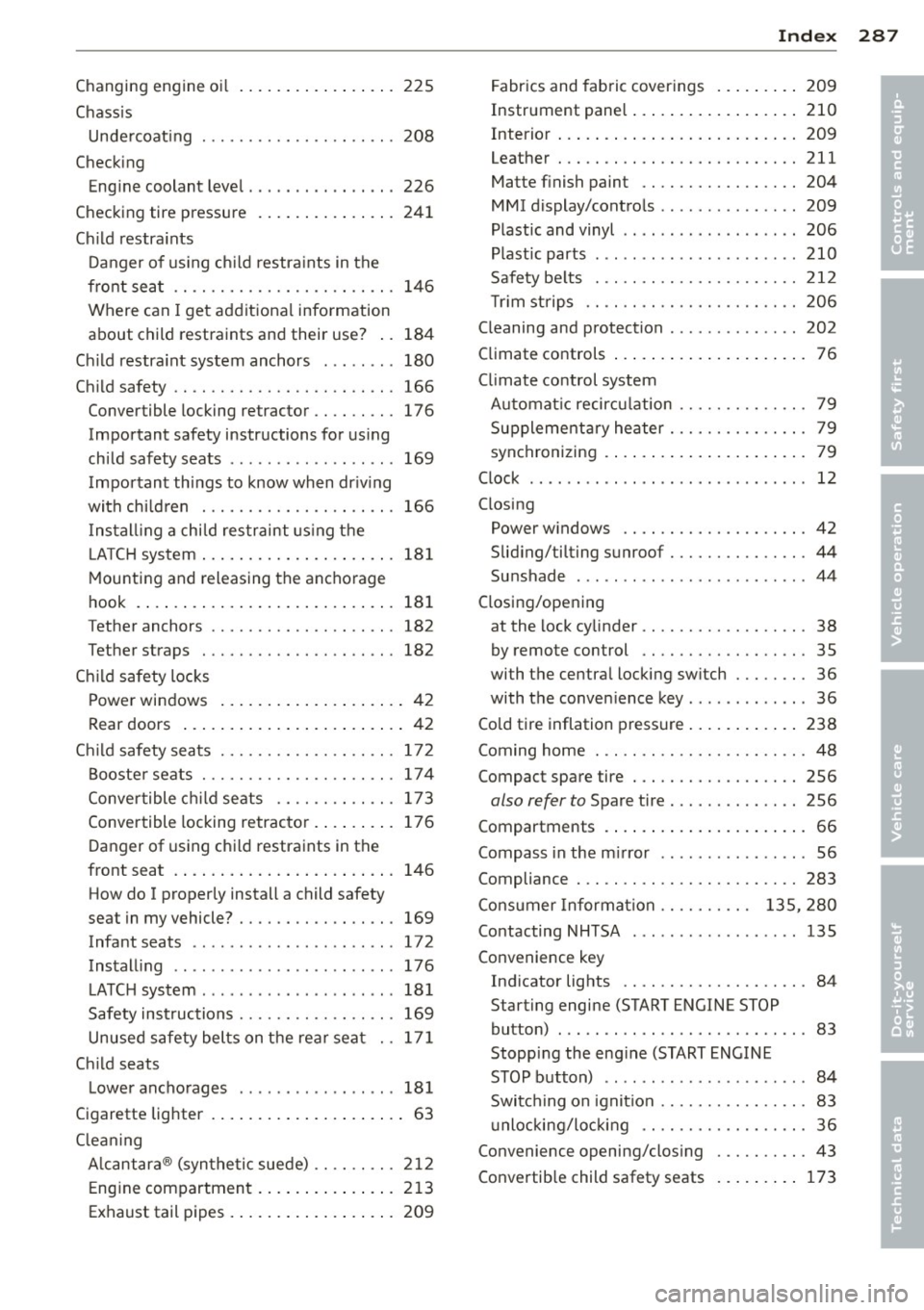
_______________________________ ___:I~n ~d ~e:.::x 287
Changin g engine oi l
Chass is 225
U ndercoat ing ............ .... .. .. . 208
Checking
Eng ine coolant level ........ . .. .. .. .
226
Checking tire pressure .............. . 241
Ch ild restraints
D anger of usin g child restraints in the
front seat . . . . . . . . . . . . . . . . . . . . . . . .
146
Where can I get additional information
about child restraints and their use? ..
184
Child restraint system anchors . .. ... .. 180
Ch ild safety .. ............. .... .. ... 166
Convertible locking retractor . . . . . . . . . 176
Important safety instructions for using
ch ild safety seats .... ... .. .. .. .. .. .
169
Impo rtant th ings to know when driv in g
wi th children ............ .... .. ...
166
Insta lling a chi ld res traint using the
L A TCH system ............ .. .. .. .. .
18 1
Mounting and releasing the ancho rage
hook .... .. .. ............. .. .. ...
18 1
Tether anchors . . . . . . . . . . . . . . . . . . . . 182
Tether straps . . . . . . . . . . . . . . . . . . . . . 182
Child safety loc ks
Power windows .......... .. .. .. ....
42
Rear doors ... ........... .. .. ...... 42
Child safety seats .......... .... .. .. . 172
Booster seats ................ .. .. . 17 4
Convertible child seats .... .. .. .. .. .
173
Convertible locking retractor .. .. .. .. . 176
Danger of using child restra ints in the
front seat . . . . . . . . . . . . . . . . . . . . . . . .
146
How do I properly install a child safety
seat in my vehicle? ........ .. .. .. .. .
169
Infant seats . . . . . . . . . . . . . . . . . . . . . . 172
Installing ............ ...... .... .. 176
LATC H system ......... ...... .... .. 18 1
Saf ety inst ruc tions ........ .. .. .. .. . 169
Unused safety belts on the rear seat 17 1
Ch ild seats
L ower ancho rages ........... .. ....
18 1
Cigarette lighter . . . . . . . . . . . . . . . . . . . . . 63
Cleaning
Alcantara® (syn thetic suede) .. .. .. .. .
212
En gine compartment .............. . 213
Exhaust tail pipes ............... .. . 209
Fabr ics and fabric coverings ......... 209
Instrument panel ... . .......... .. .. 210
Interior ... .. .. .. .. . .. .......... .. 209
Leather . . . . . . . . . . . . . . . . . . . . . . . . . . 211
Matte finish paint ................. 204
MMI display/controls ... ......... ... 209
Plastic and vinyl .. .. . .. .. .. ... ... .. 206
Plastic parts ..... .. .. .. .. ......... 210
Safety belts ... .. .. . .............. 21 2
Trim strips .. .. .. .... ........... .. 206
Cleaning and protection . .. .......... . 202
Climate controls ..... . .. .......... .. . 76
Climate control system
Au tom atic recir culat ion ......... .. .. .
79
Supplementary heater ............... 79
synchronizing . . . . . . . . . . . . . . . . . . . . . . 79
Clock .. ... ... .. .... .. .. ...... ... .. . 12
Closing
Power w indows ................... .
42
Sliding/tilting sunroof ............... 44
Sunshade ....... .. . .. ......... ... . 44
Closing/opening
at the lock cylinder .. ........... .... .
38
by remote control ............. .. .. . 35
with the centra l locking sw itch ........
36
with the conven ience key . .......... .. 36
Cold tire inflation pressure .......... .. 238
Coming home ... .. .... ........... .. . 48
Compact spare tire .................. 256
also refer to Spare tire ....... ... .. .. 256
Compartments . . . . . . . . . . . . . . . . . . . . . . 66
Compass in the mirror ... ......... ... . 56
Compliance . . . . . . . . . . . . . . . . . . . . . . . . 283
Consumer Information . . . . . . . . . . 135, 280
Contacting NHTSA .... .. ......... ... 135
Convenience key
Ind icator lights .. ................. .
84
Starting engine (START ENGINE STOP
button) . .. .. .. .. .. . .. .. ..... ..... .
83
Stopping the engine (START ENGINE
STOP button) . . . . . . . . . . . . . . . . . . . . . .
84
Switching on ignition ............... . 83
un locking/loc king ............. ..... 36
Convenience opening/clos ing .......... 43
Convertible child safety seats ......... 173
•
•
Page 291 of 302

-----------------------------~I~ n~d~ e~x 289
Emergency operation
Emergency braking function (parking
brake) ... .. .. .. ........ ... .. .. .. .. 87
E me rgency sta rting ........ .. .. .. .. . 269
Emergency towing .. .... .... . .. .. .. . 271
Energy management .... ... .. .. .. .. . 192
Battery power . . . . . . . . . . . . . . . . . . . . . 1 7
Driver notification . . . . . . . . . . . . . . . . . . 17
E ng ine
Compartment ..... .... ... .. .. .. ... 221
Coolant .... .. ... ..... ... .. .. .. ... 226
Hood . ..... .. .. ... . .... ... .. .. ... 219
Starting . . . . . . . . . . . . . . . . . . . . . . 80, 83
Start ing with jumper cables .. .. .. .. . 269
Stopping . . . . . . . . . . . . . . . . . . . . . . 82, 84
Eng ine compartment
Safety instructions ..... ... .. .. .. .. . 2 19
Working the engine compartment 219
E ng ine coolan t
I ndicator light . . . . . . . . . . . . . . . . . . . . . 18
E ng ine coolant system .......... ... .. 226
Adding coolant .............. ... ... 227
Chec kin g coolant leve l ..... .. .. .. .. . 226
Checking the eng ine coolan t leve l .. .. . 226
Ra diato r fan ............. .... .. ... 228
E ng ine coolant temperature
Temperatu re ga uge .... ...... .... ... 10
Eng ine data .. ............. .... .. ... 277
E ng ine hood
C losing . . . . . . . . . . . . . . . . . . . . . . . . . . 219
How to release the hood ... .. .. .. .. . 2 19
E ng ine oi l .. ................. ... ... 221
Adding .. .. ............. .. .. .. .. . 224
Addi tives . .. ............. .... .. ... 224
Changing .. ... .. ..... ... .. .. .. ... 225
Check oil leve l .. .. .... ... .. .. .. ... 224
Consumption ..... .... ... .. .. .. ... 224
Indicator light ........... .... .. 17,21
O il consumption .......... .. .. .. .. . 223
O il grades .. ............. .... .. ... 221
O il level symbol ............. .... ... 21
Pressu re malfunction ...... .. .. .. .. .. 17
Sensor defective . . . . . . . . . . . . . . . . . . . . 2 1
Specification and vis cos ity .. .. .. .. .. . 22 1
Eng ine speed limitat io n ..... .. .. .. .. .. 21 Environment
Break-in period ..... . ... ...... ... .. 194
Catalytic converter . .. .. ..... ... .. .. 195
Dispos ing of your ve hicle battery ... .. 233
Driving at high speeds .............. 196
Driving to minimize po llution and noise 196
Fuel . . . . . . . . . . . . . . . . . . . . . . . . . . . . . 217
Fuel economy .. .. .. ..... ......... .
Lea ks unde r you r vehicle ........ ... .
Let ting the vehicle stand and warm up .
Proper disposal of d rained brake flu id .
Proper disposal of drained engine cool
ant
. ... .. .. .. .... . ... ...... ... ..
Proper disposal of drained eng ine 196
2 19
196
229
227
o il . . . . . . . . . . . . . . . . . . . . . . . . . 224, 22S
Recycling used engine oil ............ 224
Roof rack . . . . . . . . . . . . . . . . . . . . . . . . . 68
Un leaded fuel .. .. .. . .. .... .... .. .. 214
What shou ld I do with an o ld battery? . 233
EPC
refer to Electron ic power control . . . . . . 20
ESC ( Electronic Stabi lization Contro l)
Warning/indicator lights ..... ... .. .. . 19
E thy l alco ho l (Fuel) . ............. .. .. 215
Event Data Recorder (EDR) .......... .. 185
E xhaust tai l pipes
Cleaning . ... .... .. . .. .. ..... ... .. 209
Expansion tank
Exterior lighting
E xterior m irrors 226
. .. ............... .. . 47
Adjusting . . . . . . . . . . . . . . . . . . . . . . . . . SO
D' . 1mming .. .. .... .. . .. .. ..... ... .. . 51
Heating ... .. .. .. .. .. .. .. .... ... .. . SO
F
Fan
Radiator
Fasten ing
B oos ter sea ts 228
17 4
Convertib le child sa fe ty seats .... .. .. 173
Infant seats . . . . . . . . . . . . . . . . . . . . . . 172
Fasten ing eyes
refer to Tie-downs .... ........... .. . 72
Flat tire Chang ing . .. .. .. .. . .. ....... ... .. 259
flexib le fue l
Floor
. .. .... .. . .. .. ..... ... .. 215
75
•
•
Page 293 of 302
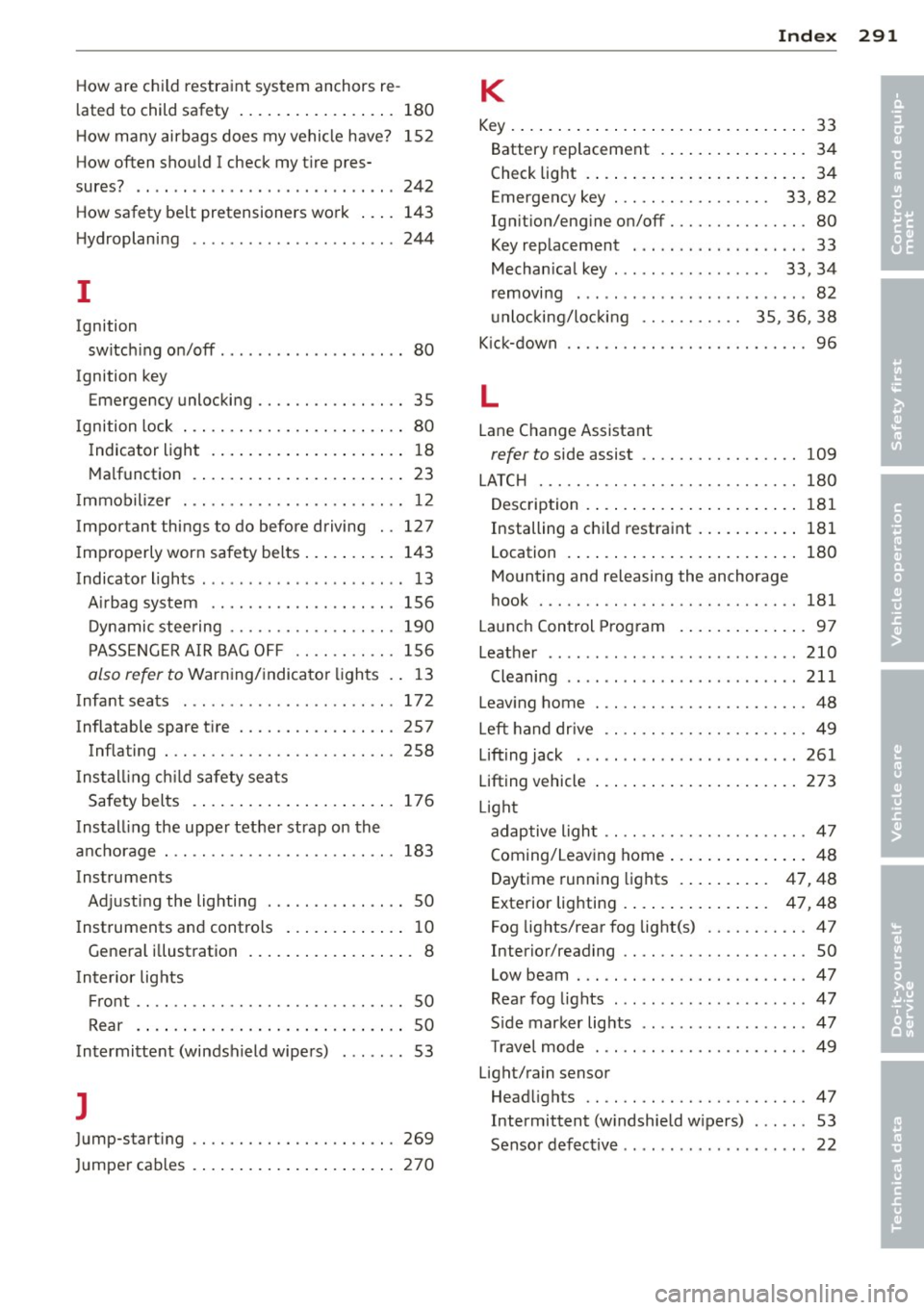
How are child restraint system anchors re-
l ated to child safety ................ . 180
H ow many airbags does my vehicle have? 152
How often should I check my tire pres-
sures? .. .. .. .. .. .. .. .... ... .. .. .. . 242
How safety belt pretensioners work ... . 143
H ydroplaning .............. ... ... .. 244
I
Ignition
switch ing on/off . .......... ... ... ... 80
Ignition key Emergency unlocking ...... .. .. .. .. .. 35
I gnition lock . . . . . . . . . . . . . . . . . . . . . . . . 80
I ndicator light . . . . . . . . . . . . . . . . . . . . . 18
Malfunction . . . . . . . . . . . . . . . . . . . . . . . 23
I mmobilizer . .... ......... .... .. .. .. 12
Important things to do before driving . . 127
I mproperly worn safety be lts .......... 143
Indicator lights ...... ...... .. .. .. .. .. 13
A irbag system ... ..... ... .. .. .. .. . 156
Dynamic steering ......... .. .. .. .. . 190
PASSENGER AIR BAG OFF .. .. .. .. .. . 156
also refer to Warning/indicator lights .. 13
Infant seats . . . . . . . . . . . . . . . . . . . . . . . 172
Inflatable spare tire ........ .. .. .. .. . 257
Inflating . .. ............. .... .. .. . 258
I nstal ling ch ild safety seats
Safety belts . ............... ... ... 176
Install ing the upper tether strap on the
anchorage . .. ............. .... .. ... 183
Instruments Adjusting the lighting ..... .. .. .. .. .. 50
Instruments and controls ......... .. .. 10
General i llustration .......... ... .. ...
8
Interior lights
Fr ont .. .. .. .. .. ........... .. .. .... SO
Rear . ... .. .. ................ ..... 50
Intermittent (windshield wipers) . . . . . . . 53
J
Jump-starting ............. .... .. .. . 269
Jumper cables ................ ... ... 270
Index 291
K
Key ......... ..... .................. 33
Battery replacement . . . . . . . . . . . . . . . . 34
Check light ...... .. ................ 34
Emergency key . . . . . . . . . . . . . . . . . 33, 82
Ignition/engine on/off .............. . 80
Key replacement . . . . . . . . . . . . . . . . . . . 33
Mechanical key . . . . . . . . . . . . . . . . . 33, 34
removing . . . . . . . . . . . . . . . . . . . . . . . . . 82
unlocking/locking . . . . . . . . . . . 35, 36 , 38
Kick-down . . . . . . . . . . . . . . . . . . . . . . . . . . 96
L
Lane Change Assistant
refer to side assist ............. .... 109
LATCH ... .. .. .. .. .... ........... .. 180
Description .. .... .. ............... 181
Installing a child restraint ......... .. 181
Location . . . . . . . . . . . . . . . . . . . . . . . . . 180
Mounting and releasing the anchorage
hook ..... .. .. .. .. .. ........... .. 181
Launch Control Program ............ .. 97
Leather .......... .. ..... ....... ... 210
Cleaning ........ .. ... ... ......... 211
Leaving home ... .. .................. 48
Left hand drive .. .. .... ........... .. . 49
Lifting jack ....... .. ... ... ......... 261
Lifting vehicle ..... .. ............... 273
Light adaptive light .. .. .. ............... . 47
Coming/Leaving home ............... 48
Daytime running lights . . . . . . . . . . 47, 48
Exterior lighting . . . . . . . . . . . . . . . . 47, 48
Fog lights/rear fog light(s) ........ .. . 47
Interior/reading . . . . . . . . . . . . . . . . . . . . SO
Low beam . .. .. .. .. ............... . 47
Rear fog lights ... .. . .. .... ........ . 47
Side marker lights .. ... ........... .. 4 7
T ravel mode ... .. .................. 49
Light/rain sensor Headlights .. .. ...... ............. . 47
Intermittent (windshield wipers) ... .. . 53
Sensor defective . . . . . . . . . . . . . . . . . . . . 22
•
•